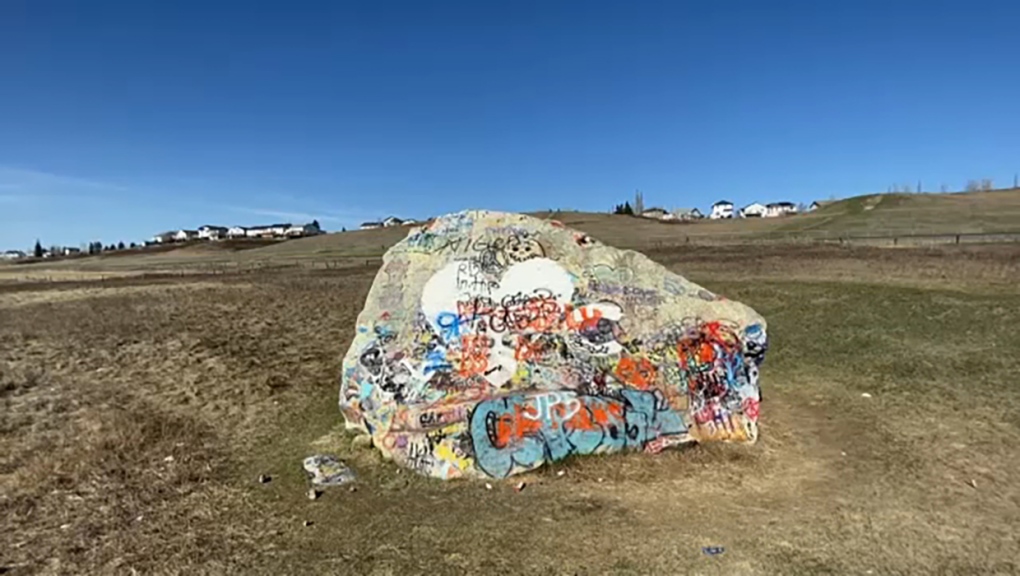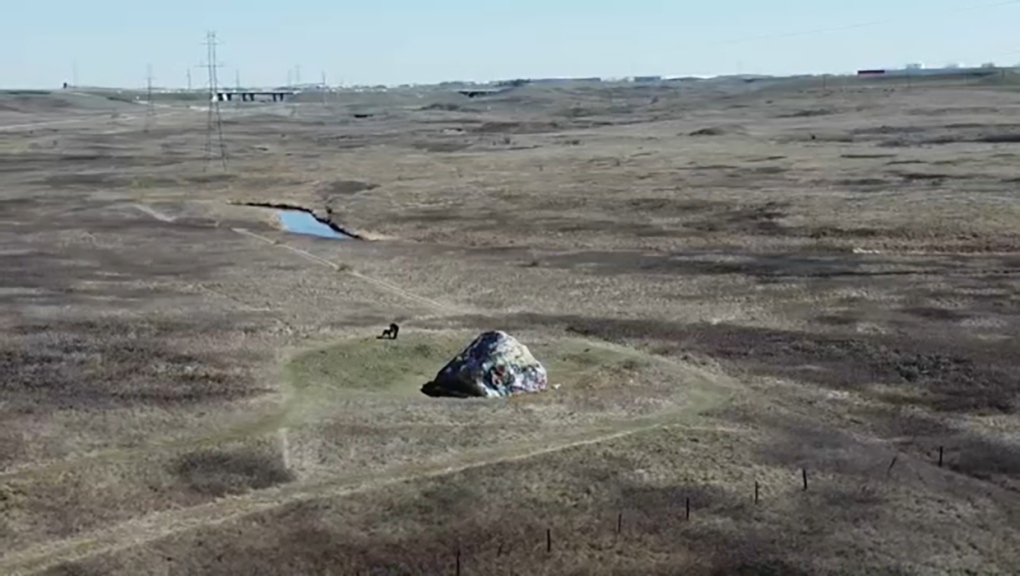Attempts underway to protect significant landmark in Alberta's ancient history
The quartzite boulder spent untold millennia riding a massive glacier all the way from Jaspers Tonquin Valley to its eventual resting place next to Nose Creek.
That was between 15 and 20,000 years ago. Sometime later, the first people walked past - and from time immemorial the Beddington erratic and dozens of others like it - became significant landmarks across the landscape.
It's not clear just when, but the first people began to leave their mark - paintings telling stories or marking events, people or nearby resources.
"All of these sacred places were all marked - even the medicine wheels and the way they point - they point to a direction where something else happened," says Grant Many Heads, an educator at Blackfoot Crossing Historical Park on Siksika.
Many Heads notes the site was just literal steps from what's now called the Old North Trail, a route that shadowed the Rocky Mountains from Alaska to Mexico. It was a major trade and travel route, a long line that connected the northern people of the boreal forest, through the Great Plains, to the canyon and desert country to the south.
"It's not just records - they are sacred," Many Heads says. "It's kinda sad that people come to these places and damage them."
GRAFFITI
That's what has happened to the substantial boulder over the years - pictures from the 1943 Alberta Geology Report show the boulder intact. As of 2000, a report on protection of similar erratics noted seven with known pictographs, including the Beddington site, located a few hundred metres north of Country Hills Boulevard and a similar distance west of Deerfoot Trail.
At the time there was no mention of graffiti, but notes from the archaeological site identified as EgPm-177 reads "The pictographs are faded and there is no record of their precise location or form."
Today the rock is covered in countless layers of paint, with fresh cans on the ground as of April 22, 2024. Four and a half metres tall and roughly 7.3 metres long and wide, little of the actual rock is visible.
 Today the rock is covered in countless layers of paint, with fresh cans laying on the ground as of April 22, 2024. Four and a half metres tall and roughly 7.3 metres long and wide, little of the actual rock is visible.
Today the rock is covered in countless layers of paint, with fresh cans laying on the ground as of April 22, 2024. Four and a half metres tall and roughly 7.3 metres long and wide, little of the actual rock is visible.
PRESERVATION
Nose Creek Preservation Society founder Andrew Yule says more needs to be done to preserve the erratic and give it a place of respect and context in Calgary's modern landscape.
"Finland has laws to protect natural monuments like glacial erratics and we don’t really have protections," Yule says. "It really takes efforts from all levels of government to make sure that significant natural monuments [. . .] like this one are protected."
The city owns the land immediately to the south - an unofficial park that has a bridge and a gravel trail, but no proper access point. The erratic itself sits just roughly 60 metres onto private land to the north.
The city says there is little if anything it can do.
Yule said his group have tried to identify the landowner to see if they can negotiate a plan for the ancient site, but haven't been successful.
"We have teams of people that are interested in helping restore it so that we can get rid of the graffiti and place actual historic markers that can tell the story so that it’s not just another rock," Yule said.
The petroglyphs were mostly painted using a naturally occurring red clay called ochre, mixed with animal fat. It has lasted at least 1,500 years in some North American sites, but does deteriorate over time and with repeated touching. The presence of even the lightest coat of spray paint can cause irreparable harm.
Yule says the valley is the final resting place of countless bison, butchered and packaged to feed the people who followed the northern herds over vast areas for thousands of years.
 Nose Creek Preservation Society founder Andrew Yule says more needs to be done to preserve the erratic and give it a place of respect and context in Calgary's modern landscape.
Nose Creek Preservation Society founder Andrew Yule says more needs to be done to preserve the erratic and give it a place of respect and context in Calgary's modern landscape.
There is still a depression around the Beddington erratic, pounded out by the feet of thegreat bison herds rubbing their winter coats.
Today that moat is the only tangible evidence left of the countless souls that passed this way since the great glaciers melted away and life in Alberta began.
CTVNews.ca Top Stories

Grandparents killed in wrong-way crash on Hwy. 401 identified
A 60-year-old man and a 55-year-old woman killed in a wrong-way crash on Highway 401 earlier this week have been identified by the Consulate General of India in Toronto.
Police arrest 3 Indian nationals in killing of B.C. Sikh activist Hardeep Singh Nijjar
Three people have been arrested and charged in the killing of B.C. Sikh activist Hardeep Singh Nijjar – as authorities continue investigating potential connections to the Indian government.
Suter scores late goal, clinches series for Canucks
Pius Suter scored with 1:39 left and the Vancouver Canucks advanced to the second round of the NHL playoffs with a 1-0 victory over the Nashville Predators on Friday night in Game 6.
TD worst-case scenario more likely after drug money laundering allegations: analyst
TD Bank Group could be hit with more severe penalties than previously expected, says a banking analyst after a report that the investigation it faces in the U.S. is tied to laundering illicit fentanyl profits.
Quebec man who threatened Trudeau, Legault online sentenced to 20 months in jail
A Quebec man who pleaded guilty to threatening Prime Minister Justin Trudeau and Premier François Legault has been sentenced to 20 months in jail.
Human remains found in rural Sask. possibly a decade old, RCMP say
RCMP say human remains found in a rural area in central Saskatchewan may have been there for a decade or more.
Britney Spears 'home and safe' after paramedics responded to an incident at the Chateau Marmont, source tells CNN
A source close to singer Britney Spears tells CNN that the pop star is 'home and safe' after she had a 'major fight' with her boyfriend on Wednesday night at the Chateau Marmont in West Hollywood.
Canadian doctor concerned new weight-loss drug Wegovy may be used inappropriately
As Wegovy becomes available to Canadians starting Monday, a medical expert is cautioning patients wanting to use the drug to lose weight that no medication is a ''magic bullet,' and the new medication is meant particularly for people who meet certain criteria related to obesity and weight.
Drew Carey is never quitting 'The Price Is Right'
Drew Carey took over as host of 'The Price Is Right' and hopes he’s there for life. 'I'm not going anywhere,' he told 'Entertainment Tonight' of the job he took over from longtime host Bob Barker in 2007.































